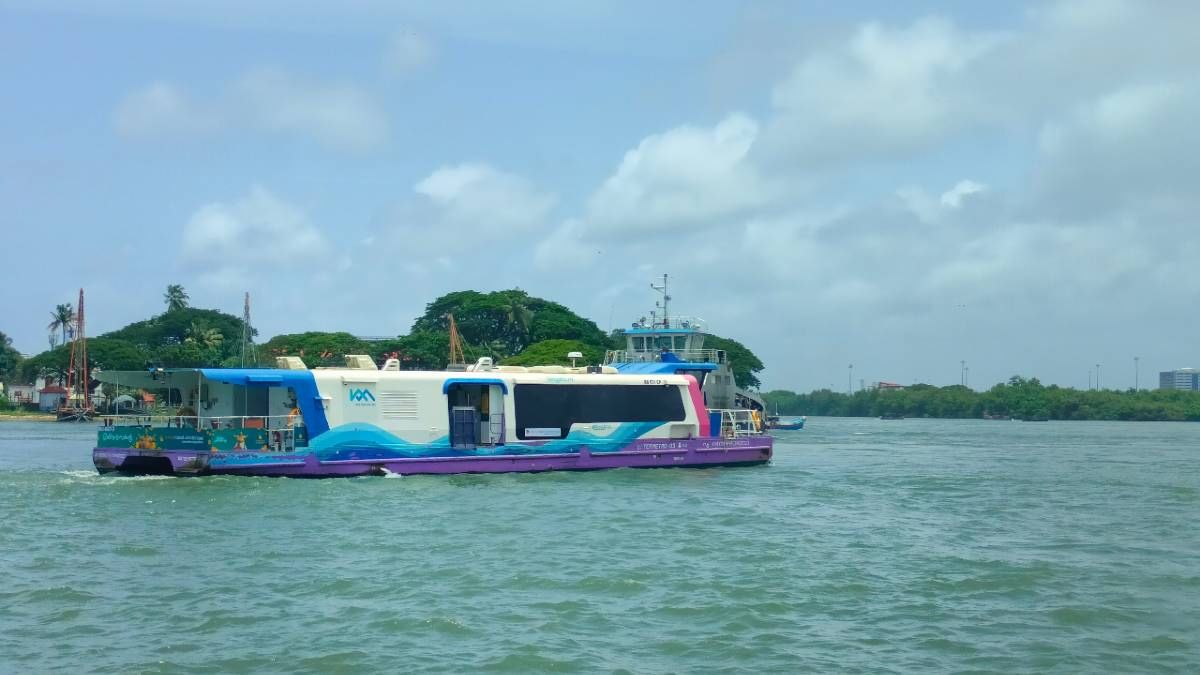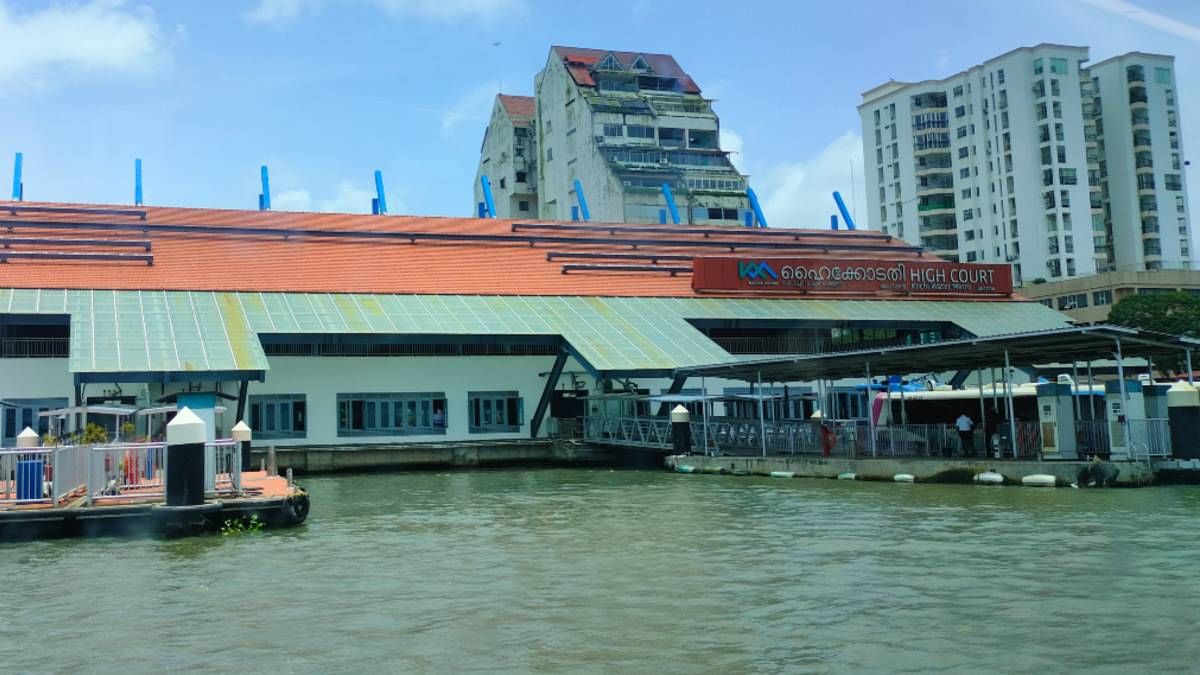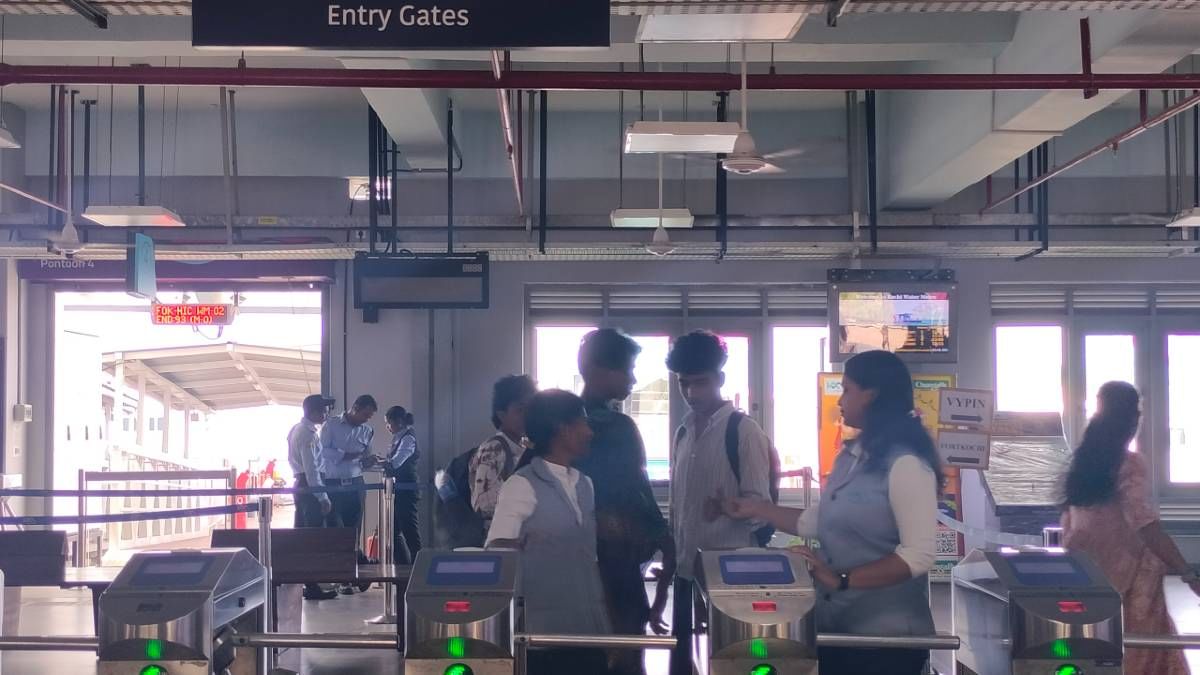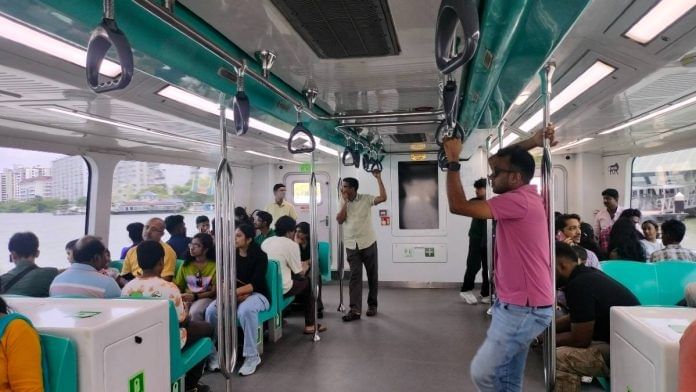Kochi: Preparing for bank exams in her native Thiruvananthapuram district, Anju S.R.’s main objective in planning a one-day trip to Kochi was to experience the Kochi Water Metro, an attraction many of her friends had raved about.
The 28-year-old’s wish finally came true Tuesday, as she sat in an air-conditioned ferry that took her and many others, both locals and tourists, through the backwaters from the city’s Marine Drive to the heritage town of Fort Kochi.
“I felt like I was taking a flight. The terminal as well as the boat were so clean,” Anju told ThePrint. The boat that took her to Fort Kochi had 90 other passengers who waited in a queue for over half an hour for their turn.
Aimed to create a socially inclusive and environmentally sustainable transport system that utilises the unique backwaters of the city, the Kochi Water Metro has been a success so far. It has helped in cutting daily commute time for residents as well as provide a brisk, pleasant journey, with more terminals in the offing.
Moreover, states such as Maharashtra and Tamil Nadu are knocking at the doors of Kochi Metro Rail Limited (KMRL), which operates and maintains the system, to understand the project and implement it in cities such as Mumbai and Chennai.
A first-of-its-kind initiative in India, inaugurated in April 2023, the Kochi Water Metro currently has 19 electric ferries connecting 10 terminals across the city. It has linked Kerala’s commercial capital’s mainland to its islands and is estimated to have served over 40 lakh passengers in just over two years. Moreover, it has boosted domestic tourism in Kerala’s most famed postcard town when foreign footfall took a major hit following the Covid pandemic.
The air-conditioned boats plying between the mainland and the city’s island towns, such as Fort Kochi, Vypin and South Chittoor, have added a new dimension to travel, which earlier relied on roads and boats run by the Kerala water transport department.

The nearly 30-minute water metro trips on each route, at a cost of Rs 40-60 per person, provide both comfort and a tourism experience to locals who earlier used non-air-conditioned boats costing Rs 6 per person or buses that took 40 minutes to an hour on the particular routes, depending on traffic.
“Perhaps the most compelling evidence of the water metro’s success comes from the lives it touches daily. For residents of the islands, the system has reduced commute times drastically, offering safe, reliable and affordable access to education, healthcare, and employment in the mainland city,” Jayakumar K. K., public relations official for Kochi Metro Rail, told ThePrint.
The project is now being expanded to more localities, including tourist spots like Mattancherry, Willingdon Island, Kumbalam, Kadamakkudy and Paliyamthuruthu. A study is also underway to connect the water metro to the airport in the city.
KMRL is, in fact, conducting feasibility studies for introducing similar systems in 18 urban centres across 11 states and two union territories at the request of the central government.
“This is a completely air-conditioned system running on electric ferries. It is environmentally friendly and the ferries can be charged in 15-20 minutes during boarding and alighting time,” Vishnu Venugopalan, principal planner at Bengaluru-based Habog Consultants Private Limited, an engineering consulting firm focussed on urban infrastructure, told ThePrint. He said the system has high potential in less connected parts of India with water networks.
Keeping up with nature
Amid the tall houseboats plying through the Kochi backwaters that mark their presence with noisy engines, the sleek water metro ferries are a calming presence. They look like a metro train compartment, in both shape as well as the aquamarine exterior and blue seats.
Designed by Cochin Shipyard, the ferries have a “low wake” design that creates minimal waves in the fragile backwaters.
“Historically, Kerala’s public transport system always relied on the waterways. Only in the last couple of decades did we start emphasising on cars and buses, which eventually reduced the importance of water transport. The Kochi Water Metro system is a good method of using the older system and our waterbodies. It also focuses on cleaning the waterbodies for its operation,” Vishnu said.
Conceptualised as early as 2015, construction of the Kochi Water Metro began in 2016 after a special purpose vehicle (SPV) was formed, with 74% share by the Kerala government and 26% by KMRL. The Rs 1,137 crore-project also received 85 million euros (Rs 579 crore) in long-term soft loan from German funding agency kfw Development Bank.
The first water metro route from High Court terminal to Vypin terminal began services on 26 April, 2023, followed by the opening of the second route from Kakkanad to Vyttila on 27 April.

According to the KMRL’s Annual Report 2023-24, the water metro served more than 20 lakh passengers in its maiden year with an average ridership of about 5,500 passengers per day.
“From the outset, the water metro was not planned in isolation. Its success lies in its seamless integration with the Kochi Metro and the city’s wider mobility ecosystem,” Jayakumar said.
Vyttila serves as the operation control centre (OCC) for the water metro. Located in southern Kochi, the OCC is at Vyttila Mobility Hub, where a metro train station, major bus terminal and water metro terminal are integrated into a single hub. Likewise, metro stations are available within 800-900 metres of the HC and Ernakulam terminals. Bus stations are also connected to other terminals.
According to the KMRL Annual Report, gross income from the project was Rs 1,133.51 lakh while Rs 1,163.25 lakh was spent towards operating expenses for 2023-24. In 2022-23, the gross income was Rs 325.79 lakh with Rs 332.94 lakh in expenses.
“For a public service project, profitability is not defined by conventional corporate benchmarks. Instead, the water metro’s business model emphasises self-sustainability through a combination of fare revenue, property development and tourism-linked income streams,” Jayakumar said, adding that the system is designed to pay for its upkeep while creating long-term social and economic value for Kochi and Kerala.
Also Read: Kerala has a ghost houses problem, but the state just doesn’t want to get into it
Expansion within Kochi & outside
With the success of the system, KMRL is now moving forward with Phase II of the project, which will extend services to more areas within and beyond the city, bringing the total to 38 terminals.
Construction is nearing completion at Mattancherry, Willingdon Island, Kumbalam, Kadamakudi, and Paliyamthuruthu. Services to Mattancherry and Willingdon Island are expected to commence shortly. Beyond the city, feasibility studies are underway to connect Kumbalam to Alappuzha district, Aluva in Kochi to Nedumbassery (home to Cochin International Airport) and Paravur in Ernakulam to Kodungallur in Thrissur district.
The journey is also extending beyond the state. Officials said KMRL is currently preparing a detailed project report for introducing the system in Mumbai with 10 routes connecting places like Vaitarna, Vasai, Manori, Thane, Panvel, etc. Preliminary studies have also been completed in Prayagraj, Varanasi, and Ayodhya, with advanced assessments ongoing in Mumbai, Patna, Ahmedabad and Surat.
“Each location presents unique ecological and geographical challenges, from tidal flows to population density, but the adaptability of the Kochi model is inspiring. Maharashtra government’s interest also shows how a megacity is preparing to replicate a concept born in the backwaters of Kerala,” Jayakumar said.
Impact on local economy
At the High Court water metro terminal, a cheerful Dixy Paxen stands at the entry gates as passengers enter the boarding area after collecting their tickets. The 34-year-old collects the MetroCards, scans them, and guides passengers to the waiting area.
Wearing black pants with a white shirt and grey overcoat that has the water metro logo and that of Kudumbashree, a women empowerment programme implemented by the state government, she faces a myriad of questions from passengers, ranging from “when is the next boat to Fort Kochi” to “when will services start to Kadamakkudy”. She answers all while manning a long queue.

A B.Ed graduate, Dixy found her job at the Kochi Water Metro after she couldn’t continue teaching due to health issues following an accident. The Vypin resident sent her resume after her Kudumbashree unit informed her that KMRL was hiring staff from villages around the water metro terminals. Now, she is one of 13 Kudumbashree staff deployed at the HC terminal, handling ticketing, gate operations and cleaning.
“Fort Kochi is the busiest route. Many come here just to experience the water metro. So, if the service is busy, they will settle for other destinations too,” Dixy told ThePrint, adding that queues often stretch to the road during holidays. She said ferry services to Fort Kochi run every 15 minutes, while other locations are less frequent.
However, she observes that locals still prefer buses or government boats, which are cheaper. For example, a water metro ticket from High Court to Fort Kochi terminal costs Rs 50 while the non-air-conditioned government boats cost just Rs 6 for the same 20-minute journey.
On the opposite side of the High Court terminal lies Fort Kochi, the heritage island where streets scream its European past. Here, 62-year-old Asharaf V. K. runs an antique shop just outside the water metro terminal, catering to passengers stepping out.
He says the water metro has revived local business. “Post-Covid, foreigners aren’t coming as much, and our sales dipped. Now, we are seeing more Malayalees from other districts and many travellers from Tamil Nadu and Karnataka, to see the place and experience the water metro,” he said.
The nature of the local market has changed, too. A neighbouring shop that once sold only antiques converted one side into a juice stall last year.
“Fort Kochi was focused on foreign tourists earlier. Now more locals are coming. Sales are steady again, and the water metro has been a big benefit. Our shop timings even depend on it, the last service to Fort Kochi is at 8.30 pm, so we close just after that,” he added.
(Edited by Nida Fatima Siddiqui)
Also Read: Electric-hybrid boats connecting 10 Islands — ‘one-of-a-kind’ water metro service to launch in Kochi






